This was published 7 years ago
Cape York road trip guide: How to get to the northernmost point of Australia
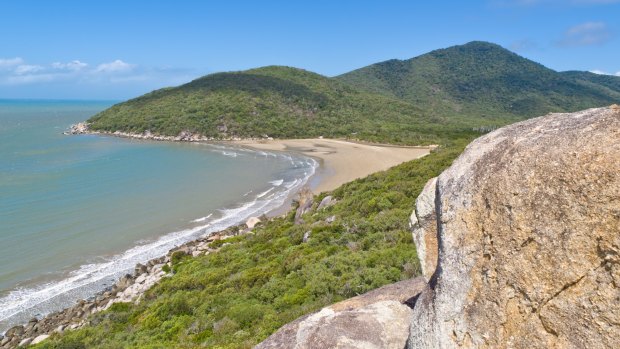
Frontier township: Cooktown.Credit: iStock
'Listen to the wind blow, Watch the sun rise… Break the silence, Damn the light, Damn the dark…"
Fleetwood Mac are near on deafening me, but no way will I turn them down, we all need a soundtrack to our lives. The sun – squeezed tight through a forest of gigantic palms and green tree ferns – is creating shadows on the road that mess with my mind: was that a wallaby crossing? Good strong coffee – the best I've had in a week – is pumping adrenalin through my nervous system, I can feel it straining at the bones behind my ears.
All that remains is this last 11 kilometres… 11,000 metres… 110,000 centimetres. I've bathed in lonely creeks with crocs, I've crossed swollen rivers where water rushed up over my bonnet, I've ordered steaks that came crumbed, for God's sake… and the dust? Well, let's just say: red dust comes at me in my dreams.
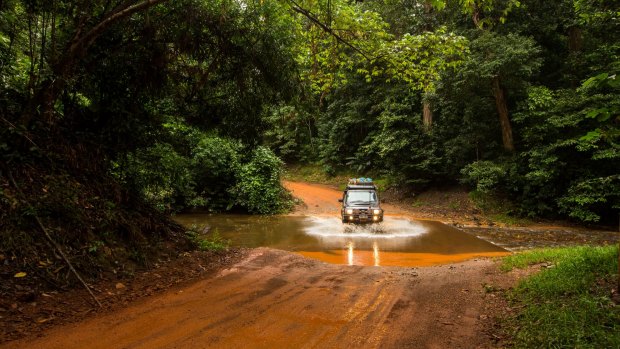
Getting to Cape York includes plenty of rainforests and creek crossings on the way.Credit: Andrew Tallon
"You going north or south?" it's all they ask round here; but then, up here, there are only two ways to go. And now, the end is nigh, the Tip…Pajinka… Cape York. You can't go further north, unless this Land Cruiser can make it across Torres Strait.
Big, blue Ulysses butterflies flutter above the road, between songs I hear birds cry out in the forest canopy. It's good to finally be here… isn't it? The anticipation has nigh on killed me, but now Pajinka's just round the corner, the truth is: I wish it was further still.
Ten days stuck in a car, now I don't want this drive to end: what the hell is wrong with me? But it gets under your skin, this place; the kinship on the road, the shared purpose of the same goal: make the Tip, whatever it takes. And in 10 minutes it'll be all but over… and I'm not sure how I feel about that.
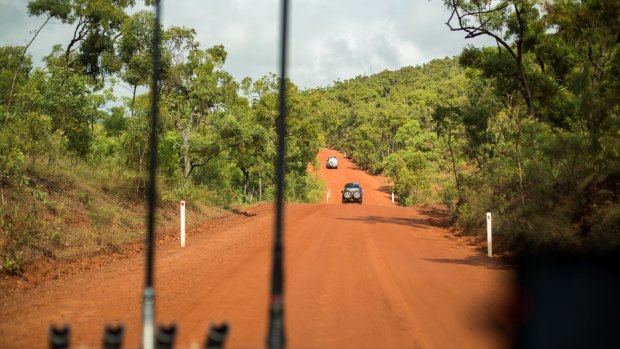
The road to Cape York is a red dusty one with a lot of bumps along the way.Credit: Andrew Tallon
By 2020, the road to Cape York will be bitumen. When the Queensland Government goes ahead with plans to pave a road all the way through, your grandma's Datsun will be able to make it to the Tip. And then this kind of journey – a 4WD adventure through some of the wildest real estate on Earth – will become a thing of the past; a relic from another era. But for now, a journey to the top of Australia remains the most revered pilgrimage in this country.
But I've never been much for road trips, childhood holidays might take the blame for that. Any time I've seen brigades of 4WDs pull up in some outback town, I've wondered what is about the road that renders them all so senseless; prone to driving days on end with little break, searching for some sort of happiness around the corner that they just can't find at home.
So it's with no small measure of surprise that I find myself in the front seat of a 4WD driven by a bloke called Martin Josselyn who's taking me more than 1200 kilometres from Cairns to Cape York. As Cairns trails behind me in the rear-vision mirror, I try to rationalise why I'm here at all. Maybe it's because I once went on a North Queensland road trip with a car full of backpackers, and some kind of fire ignited deep within me. It was something about the perpetual motion of our journey, and the wonder of the unknown. Even when I stood filling up at the petrol bowser, I wondered where this tank might get me. Whatever it was, I'd never really had the chance to stoke it.
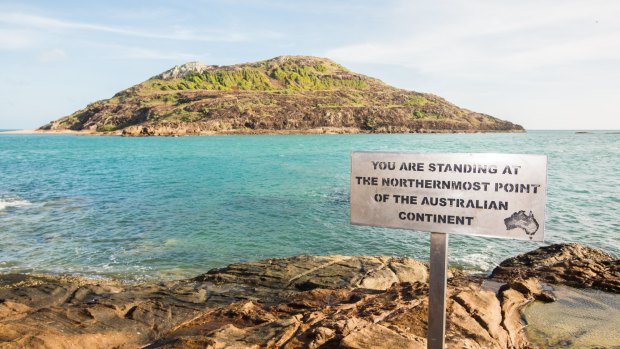
When you get to Pakinja there's nowhere further to go unless your 4WD can make it to PNG.Credit: Andrew Tallon
"Dunno how many times I've been to the Tip," Josselyn says to me, bringing me back to the present. "Thirty or 40 I reckon, but the rain washes the road away every year, so it's different every time." Josselyn's the kind of bloke who's never wasted a single word in his entire life; so when he gets out of his 4WD after crossing the swollen, croc-infested Daintree River to talk with a bloke in a muddy 4WD coming the opposite direction, I figure they're not dissecting cricket scores. I listen in. "No chance, mate," the bloke's telling Josselyn. "It's bloody high, mate." Josselyn steps back into his rig, and looks at me with a twisted grin. "The BOM's (Bureau of Meterology) not much good up here," he tells me. "Nothing beats the bush telegraph, word of mouth gets you through. Though everyone's got their own take on things."
There's a creek or two to cross before we reach Cooktown – at one I come face to face with a cassowary, one of the world's most endangered bird species – but I suspect this is child's play compared to what lies ahead. Josselyn's eyes are already starting to glaze over in a mildly disturbing manner when he speaks of the Big Two crossings we'll have to make before we reach the Tip. His words might well be economical, but the meaning in them is clear. "The difference between a good trip and a bad trip up here is if you bring your vehicle back," he says, with a twisted grin.
We make it to the frontier township of Cooktown by late afternoon. There's bitumen on every street, some shops even open seven days a week and there's Wi-Fi at my motel, though the manager's hesitant to give out the password. "Ah, bloody hell," he says with a shake of his head. "You people are all addicted." Josselyn advises I "suck up the 21st century" – where we're going there's no internet, there's few paved roads, there's little mobile phone reception, and up there, apparently, people drink their red wine chilled… and with ice in it.
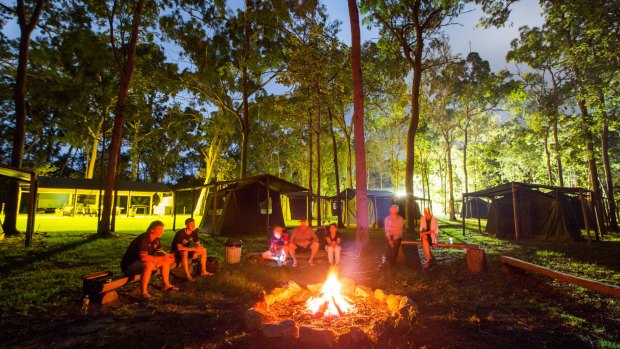
A campfire under the stars on the way to the Tip.Credit: Andrew Tallon
I'd love to tell you the road turns to ruin the moment we leave Cooktown. But the truth is there are patches of paved road almost all the way up to the Tip. It's just Josselyn does his best to avoid it. He's been "doing the Tip" since the whole way up was compacted red mud with corrugations that could break a spine. On this journey we'll often take the rocky road option even when the smooth one beckons, just to "get the true experience," as Josselyn puts it. Some might call that adventure, others might call it sadism.
I'm surprised by the diversity of the landscape – the moment I grow tired of red dusty waste land, we change tack and head east to the coast, passing beside 500-metre-high coastal mountains and rainforest as thick and as green as the Daintree. There are beaches with no one on them. At one, Chilli Beach, a strip of white luminous sand stretches more than 10 kilometres south in a gigantic horseshoe that ends at the Lockhart River. It's hot as hell and I'm tempted to swim in the clear, blue water. "Remember," guide Alex Oswald warns. "Crocs are an ambush animal, if they miss you in the first 10 metres, you should be OK."
Next morning, we take off west, scorning the bitumen for a legendary trail known as Frenchman's Track. It's so corrugated that sometimes I swear I'm working a jackhammer. "The roads used to all be like this in the '80s," Josselyn says nostalgically. There are potholes so big and wide it's better to think of them as chasms. And then we hit the Pascoe. Before we go any further, I should tell you: the Pascoe River is full of salt-water crocs. Maybe that's why Josselyn keeps his Blundstones on as he crosses it by foot, gauging the depth and plotting his path.
"Yeah," he says when he's back on our side. "It's alright".
He tells me to take anything valuable off the floor. And then we cross. And the Pascoe comes right on up over our bonnet and up to our windscreen; some of the Pascoe even pours in through the door. Josselyn doesn't look a bit flustered, not even when we grind over boulders the size of VWs on the climb out. "Wait till Gunshot Creek, mate," he says, with a grin.
When I'm not up to my eyeballs in muddy rivers, I discover there's a certain meditative quality to travelling round here. My initial restlessness passes, replaced by a peacefulness brought on by kilometre after kilometre of road where hawks circle above in search of road kill and enormous lizards stare, challenging anyone who dares pass by.
At nights we stop to camp (the tents and beds are set up by the drivers), often at roadhouses – a melting pot of Australian culture if ever I've seen one. A freshwater creek is always close by – just the spot for a cold beer and a soak – though there's a story about a salt-water croc at every one of them. But it's the social side to being here I like most. There's a strong sense of community around roadhouses; everyone's coming or going and it's up to you to work out which one it is. Travel notes are compared, water depths debated, 4WD gear reviewed. They sure love a chat up here, though I can't help but spot the disappointment in other bloke's eyes when they realise I don't understand a darn thing about Josselyn's 4WD parked out front.
We pass through Steve Irwin Reserve, entering it as you might expect, by way of a daunting rock pathway hidden beneath a metre-high river that's the most croc-infested in Australia. We hit the Old Telegraph Track, for a rendezvous with Josselyn's beloved Gunshot Creek – an almost 90-degree descent straight down a seven-metre-high muddy bank into a creek no vehicle should rightly survive.
And then I'm straddling Pajinka – with all of Australia below me. The northernmost tip of your country is a mess of barnacles, set below a pretty headland of sedimentary rock. And while I'm busy wondering whether it's the journey, or the destination, that really matters up here, I see a tiny plaque on the rocks beside me. "Mickeyboy 1954 – 2015. Didn't quite make it, But is here in spirit. RIP."
Whether or not they pave the whole damn road to Cape York, getting here's always going to matter, even if you don't have to cross a single river doing it.
"It's a rite of passage," Josselyn says beside me. "Righto, let's go get a cuppa."
TRIP NOTES
MORE INFORMATION
traveller.com.au/tropical-north-queensland
queensland.com/tropicalnorthqueensland
GETTING THERE
All major airlines fly to Cairns from Sydney or Melbourne. The Cape can be discovered as a self-drive adventure, by hosted tour, or tag-along (using your own vehicle with a hosted tour).
TOURING THERE
Adventure Australia Treks & Tours offer a 10-night-11-day premium tour, including meals, accommodation and attractions for $6950 a person (or $2500 as tag-along). Their next tours are scheduled for May, June and August, 2017, see aatt.com.au
Craig Tansley travelled courtesy of Tourism & Events Queensland and Adventure Australia Treks & Tours.
Sign up for the Traveller Deals newsletter
Get exclusive travel deals delivered straight to your inbox. Sign up now.